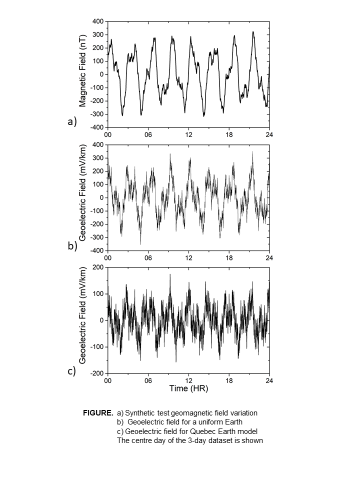Datasets
Open Access
Analytic Geomagnetic and Geoelectric Fields
- Citation Author(s):
- Submitted by:
- David Boteler
- Last updated:
- Tue, 05/17/2022 - 22:21
- DOI:
- 10.21227/gnev-dd52
- Data Format:
- Link to Paper:
- License:
- Creative Commons Attribution
 470 Views
470 Views- Categories:
- Keywords:
Abstract
Geomagnetic field variations produce geoelectric fields that can affect the operation of technological networks at the Earth’s surface, including power systems, pipelines, phone cables and railway circuits. To assess the geomagnetic hazard to this technology, it is necessary to model the geomagnetically induced currents (GIC) produced in these systems during geomagnetic disturbances. This requires use of geomagnetic data with appropriate Earth conductivity models to calculate the geoelectric fields that drive GIC. To provide a way of testing geoelectric field calculation software, we provide a benchmark test case by defining a synthetic geomagnetic field variation and deriving exact analytic expressions for the Earth response based on both uniform and layered Earth conductivity models. These are then used to provide exact analytic expressions for the geoelectric fields that would be produced by the synthetic geomagnetic field variation. The synthetic geomagnetic data can be used as input to numerical geoelectric field calculation software, the output of which can be tested by comparison with the analytically-generated geoelectric fields.
The dataset contains files of geomagnetic and geoelectric field values generated by analytic calculations. These are provided for testing software used for calculating geoelectric fields produced by geomagnetic disturbances.
The geomagnetic field dataset is to be used as a test input to geoelectric field calculation software.
The analytic geoelectric field datasets are to be used for checking the output from geoelectric field calculation software. The paper (Boteler et al, 2019) shows the accuracy that can be achieved with real software if the calculations are set up correctly.
Two sets of data are provided: One sampled once a second and containing 7 frequency components, and one sampled once a minute and containing 6 frequency components (ie with the highest frequency component removed).
Dataset Files
Analytic geomagnetic field variation: 1 minute sampling interval B_Analytic_1min.txt (101.82 kB)
Analytic geoelectric field for uniform earth model: 1 minute sampling interval E_Analytic_Uniform_1min.txt (101.81 kB)
Analytic geoelectric field for Quebec earth model: 1 minute sampling interval E_Analytic_Quebec_1min.txt (101.87 kB)
Analytic geomagnetic field variation: 1 second sampling interval B_Analytic_1sec.txt (6.42 MB)
Analytic geoelectric field for uniform earth model: 1 second sampling interval E_Analytic_Uniform_1sec.txt (6.42 MB)
Analytic geoelectric field for Quebec earth model: 1 second sampling interval E_Analytic_Quebec_1sec.txt (6.42 MB)
Open Access dataset files are accessible to all logged in users. Don't have a login? Create a free IEEE account. IEEE Membership is not required.
Documentation
| Attachment | Size |
|---|---|
| 343.79 KB |






